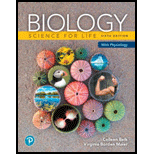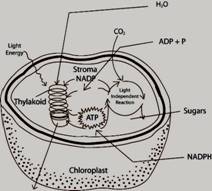
Concept explainers
Add labels to the figure that follows, which illustrates the product and reactants of photosynthesis and the relationship between its light reactions and light-independent reactions.

To label:
The given figure, which illustrates the product and reactants of photosynthesis and the relation between its light reaction and light-independent reactions.
Introduction:
Photosynthesis is a phenomenon that changes solar energy to chemical energy needed by all living organisms. Photosynthesis occurs in chloroplasts that found in the green part mainly in leaves of the plants.
Explanation of Solution
Photosynthesis can be broken down into two steps - light reaction and light-independent reaction.
Light reaction - Light reaction occurs when there is sunlight. Sunlight hits the chlorophyll molecule in the thylakoid membranes that excites electrons. These electrons are captured and passed through an electron transport chain that generates the energy-carrying molecules ATP. The electrons then transfer to the molecule NADPH. The electrons removed from chlorophyll in this way are replaced by those from water, which decompose to release them, a reaction that produces oxygen as a waste product.
Light-independent reaction - The ATP and the electrons in NADPH are utilized in the synthesis of sugar from CO2 in the second major step of photosynthesis called light-independent reactions. It occurs mainly in the stroma of the chloroplast and is sometimes referred to as the Calvin cycle.
The following labeled figure shows the products and reactants and the relation between its light-independent reaction and light reaction.

Fig:
The process of photosynthesis.
Thus, photosynthesis happens in two steps - light reaction and light-independent reaction.
Want to see more full solutions like this?
Chapter 5 Solutions
Biology: Science for Life with Physiology (6th Edition) (Belk, Border & Maier, The Biology: Science for Life Series, 5th Edition)
- This entire structure using lifecycle terminology is called what? megastrobilus microstrobilus megasporophyll microsporophyll microsporangium megasporangium none of thesearrow_forwardHow much protein should Sarah add to her diet if she gets pregnant? Sarah's protein requirements during pregnancy would be higher. See Hint B2. During calculations, use numbers rounded to the first decimal place. In your answer, round the number of grams to the nearest whole number. _______ g ?arrow_forwardC MasteringHealth MasteringNu X session.healthandnutrition-mastering.pearson.com/myct/itemView?assignment ProblemID=17396422&attemptNo=1&offset=prevarrow_forwardMost people, even those who exercise regularly at low to average intensity (1 hour at the gym or a 2- to 3-mile walk several times per week), do not need an increased protein intake. What would be the protein needs of a man named Josh who exercises moderately and is the same age and size as Wayne? Josh is 5 ft, 8 in tall and weighs 183 lb. Round the number of grams to the nearest whole number. During calculations, use numbers rounded to the first decimal place. Because protein requirement is a range, please enter two numbers: lower and upper range values, respectively. Separate the lower and upper range values, in that order, by a comma. ___, ___ g ?arrow_forwardC MasteringHealth MasteringNu X session.healthandnutrition-mastering.pearson.com/myct/itemView?assignment ProblemID=17396422&attemptNo=1&offset=prevarrow_forwardIf left untreated, most HIV-infected individuals will develop AIDS. Current treatments are focused on highlyactive antiretroviral therapy (HAART). HAART usually consists of an orally delivered drug cocktail containingtwo different reverse transcriptase inhibitors and one other drug, such as a protease inhibitor. Question: Develop a pharmacokinetic model of HAART treatment. Consider all 3 drugs. Make sure to include adiagram that illustrates your thinking, state all assumptions, and define your variables. Whatparameters would you need to know to find the concentration of drug in the plasma? In the T cells?(You do not need to write out or solve any equations.)arrow_forwardnot use ai pleseaarrow_forward(A) 25 20 20 15 NPP (Mg C/ha/yr) 10 10 5 0 0 2,000 4,000 6,000 ECOLOGY 4e, Figure 20.11 (Part 1) 2017 Sinauer Associates, Inc. Average annual precipitation (mm) 8,000arrow_forwardexplain the cascade of events (starting with relaxing trade winds) that occurs during El Niño in the eastern Pacific (off the coasts of California/North America and Peru/South America) and which lead to food-chain collapse - start with changes in the physical/oceanographic conditions, andthen systematically describe the cascading effects at each level of the food chain -arrow_forward3) Which statement(s) about the Pacific Decadal Oscillation (PDO) is/are TRUE? CIRCLE ALL THAT APPLY. A. It is a major driver of salmon populations in the Pacific B. It affects sea surface temperatures in the eastern Pacific C. Its cycles typically do not last as long as those of ENSO D. Evidence that it has occurred over many centuries has been gathered from tree ring dataarrow_forward4.arrow_forward2arrow_forwardarrow_back_iosSEE MORE QUESTIONSarrow_forward_iosRecommended textbooks for you

 Concepts of BiologyBiologyISBN:9781938168116Author:Samantha Fowler, Rebecca Roush, James WisePublisher:OpenStax College
Concepts of BiologyBiologyISBN:9781938168116Author:Samantha Fowler, Rebecca Roush, James WisePublisher:OpenStax College Biology 2eBiologyISBN:9781947172517Author:Matthew Douglas, Jung Choi, Mary Ann ClarkPublisher:OpenStax
Biology 2eBiologyISBN:9781947172517Author:Matthew Douglas, Jung Choi, Mary Ann ClarkPublisher:OpenStax Biology (MindTap Course List)BiologyISBN:9781337392938Author:Eldra Solomon, Charles Martin, Diana W. Martin, Linda R. BergPublisher:Cengage Learning
Biology (MindTap Course List)BiologyISBN:9781337392938Author:Eldra Solomon, Charles Martin, Diana W. Martin, Linda R. BergPublisher:Cengage Learning Biology: The Dynamic Science (MindTap Course List)BiologyISBN:9781305389892Author:Peter J. Russell, Paul E. Hertz, Beverly McMillanPublisher:Cengage Learning
Biology: The Dynamic Science (MindTap Course List)BiologyISBN:9781305389892Author:Peter J. Russell, Paul E. Hertz, Beverly McMillanPublisher:Cengage Learning Biology Today and Tomorrow without Physiology (Mi...BiologyISBN:9781305117396Author:Cecie Starr, Christine Evers, Lisa StarrPublisher:Cengage Learning
Biology Today and Tomorrow without Physiology (Mi...BiologyISBN:9781305117396Author:Cecie Starr, Christine Evers, Lisa StarrPublisher:Cengage Learning

 Concepts of BiologyBiologyISBN:9781938168116Author:Samantha Fowler, Rebecca Roush, James WisePublisher:OpenStax College
Concepts of BiologyBiologyISBN:9781938168116Author:Samantha Fowler, Rebecca Roush, James WisePublisher:OpenStax College Biology 2eBiologyISBN:9781947172517Author:Matthew Douglas, Jung Choi, Mary Ann ClarkPublisher:OpenStax
Biology 2eBiologyISBN:9781947172517Author:Matthew Douglas, Jung Choi, Mary Ann ClarkPublisher:OpenStax Biology (MindTap Course List)BiologyISBN:9781337392938Author:Eldra Solomon, Charles Martin, Diana W. Martin, Linda R. BergPublisher:Cengage Learning
Biology (MindTap Course List)BiologyISBN:9781337392938Author:Eldra Solomon, Charles Martin, Diana W. Martin, Linda R. BergPublisher:Cengage Learning Biology: The Dynamic Science (MindTap Course List)BiologyISBN:9781305389892Author:Peter J. Russell, Paul E. Hertz, Beverly McMillanPublisher:Cengage Learning
Biology: The Dynamic Science (MindTap Course List)BiologyISBN:9781305389892Author:Peter J. Russell, Paul E. Hertz, Beverly McMillanPublisher:Cengage Learning Biology Today and Tomorrow without Physiology (Mi...BiologyISBN:9781305117396Author:Cecie Starr, Christine Evers, Lisa StarrPublisher:Cengage Learning
Biology Today and Tomorrow without Physiology (Mi...BiologyISBN:9781305117396Author:Cecie Starr, Christine Evers, Lisa StarrPublisher:Cengage Learning